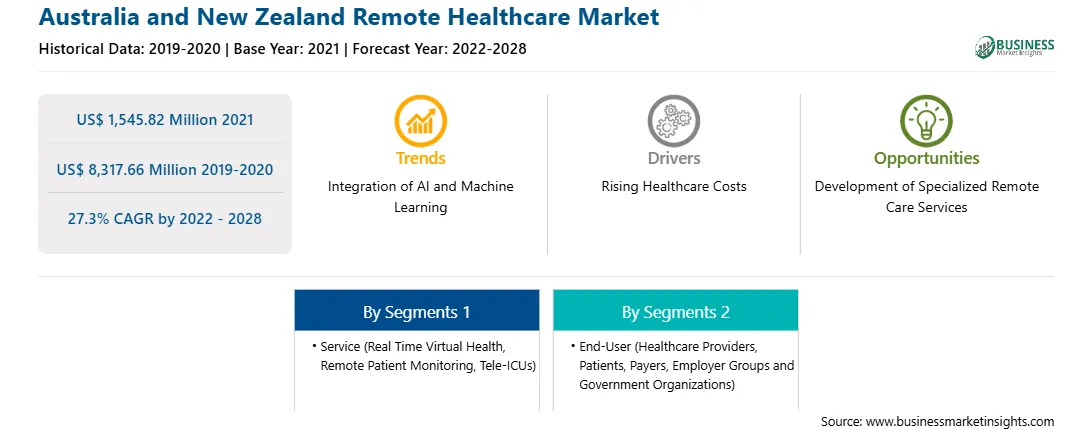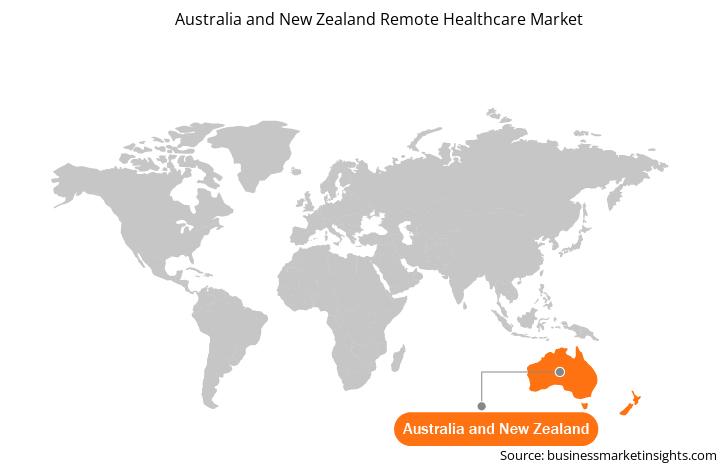The Australia and New Zealand remote healthcare market was valued at US$ 1,545.82 million in 2021 and is expected to reach US$ 8,317.66 million by 2028; it is anticipated to record a CAGR of 27.3% from 2022 to 2028.
The market growth is mainly attributed to factors such as the rise in the use of telehealth and virtual care during the COVID-19 pandemic and the increase in investment in telehealth. However, data safeguarding concerns are hampering the market growth.
In Australia's vast distances, difficult terrain, and, many rural areas are far from centralized health resources and specialist facilities, resulting in the growth of the remote health industry in Australia. Centralization of health care has become accessible due to advancements in mobile health (mHealth), telemedicine, telehealth, and remote patient monitoring (RPM) systems. Citizens of Australia and New Zealand are tech-savvy and eager to accept and purchase new technology, assuring market connectedness. Australia and New Zealand offer a variety of collaboration and investment opportunities. The Australian Government has also approved nationwide funding for telehealth services, which is now a permanent change, resulting in rapid adoption of telehealth services.
Digital Solutions for Aging Population
According to a new data projection based on results from the 2021 census, the population aged 65 and over in Australia is expected to grow by 54%, from ~4.31 million to 6.66 million, by 2041. Moreover, according to the New Zealand government, the population aged above 65 (0.79 million in 2020) has a 90% probability of increasing to 1.36–1.51 million by 2048. The geriatric population will continue to grow. This will bring several challenges, such as the rise of chronic diseases and an increase in the need for essential services for older people, including mental health services. Policy reforms like the Aged Care Royal Commission, digital transformation, wearable devices, and smart modular housing are likely to provide the biggest opportunities to revolutionize aged care in 2022 and beyond. The trend is quite predictable, considering the cumulative effects of the aging population, the high cost of in-patient care, and the enormous pressure on hospitals caused by COVID-19. Healthcare providers are already using more equipment for remote monitoring than ever before. Remote healthcare focuses on patients with chronic diseases, post-operative patients, senior patients, and patients from rural areas with limited access to healthcare facilities.
Based on service, the Australia and New Zealand remote healthcare market is segmented into real time virtual health, remote patient monitoring, and tele-ICUs. The remote patient monitoring segment held the largest market share in 2021, and the real time virtual health segment is expected to register the highest CAGR during the forecast period. Real-time virtual health, also called live telemedicine, uses video conferencing to provide virtual visits with healthcare providers. It helps patients interact with their healthcare providers, making it easy for a doctor-patient visit anytime, anywhere. It includes two-way communications (including video conferencing and phone consultations) that let providers and patients communicate in real time. It also helps in assessments of medical history, basic visual examinations, psychiatric evaluations, and even ophthalmic tests via real-time telemedicine. Several different mediums are utilized for this purpose, including phones and computers. Furthermore, Med2Wheels is the world's first portable real-time telemedicine kiosk that provides real-time telemedicine service at the doorstep that can be booked on call through a mobile application (iOS /Android). Based on end user, the Australia and New Zealand remote healthcare market is segmented into healthcare providers, patients, payers, and employer groups & government organizations. The healthcare providers segment held the largest share of the market in 2021. However, the payers segment is anticipated to register the highest CAGR in the market during the forecast period.
The World Health Organization (WHO), Australian Bureau of Statistics, Australian Digital Health Agency, Health Care Service Corporation, NZ Telehealth Forum, International Trade Administration, and New Zealand Telehealth Leadership Group are among the major primary and secondary sources referred to while preparing the report on the Australia and New Zealand remote healthcare market.
Strategic insights for the Australia and New Zealand Remote Healthcare provides data-driven analysis of the industry landscape, including current trends, key players, and regional nuances. These insights offer actionable recommendations, enabling readers to differentiate themselves from competitors by identifying untapped segments or developing unique value propositions. Leveraging data analytics, these insights help industry players anticipate the market shifts, whether investors, manufacturers, or other stakeholders. A future-oriented perspective is essential, helping stakeholders anticipate market shifts and position themselves for long-term success in this dynamic region. Ultimately, effective strategic insights empower readers to make informed decisions that drive profitability and achieve their business objectives within the market.

| Report Attribute | Details |
|---|---|
| Market size in 2021 | US$ 1,545.82 Million |
| Market Size by 2028 | US$ 8,317.66 Million |
| CAGR (2022 - 2028) | 27.3% |
| Historical Data | 2019-2020 |
| Forecast period | 2022-2028 |
| Segments Covered |
By Service
|
| Regions and Countries Covered | Australia
|
| Market leaders and key company profiles |
|
The geographic scope of the Australia and New Zealand Remote Healthcare refers to the specific areas in which a business operates and competes. Understanding local distinctions, such as diverse consumer preferences (e.g., demand for specific plug types or battery backup durations), varying economic conditions, and regulatory environments, is crucial for tailoring strategies to specific markets. Businesses can expand their reach by identifying underserved areas or adapting their offerings to meet local demands. A clear market focus allows for more effective resource allocation, targeted marketing campaigns, and better positioning against local competitors, ultimately driving growth in those targeted areas.

The Australia and New Zealand Remote Healthcare Market is valued at US$ 1,545.82 Million in 2021, it is projected to reach US$ 8,317.66 Million by 2028.
As per our report Australia and New Zealand Remote Healthcare Market, the market size is valued at US$ 1,545.82 Million in 2021, projecting it to reach US$ 8,317.66 Million by 2028. This translates to a CAGR of approximately 27.3% during the forecast period.
The Australia and New Zealand Remote Healthcare Market report typically cover these key segments-
The historic period, base year, and forecast period can vary slightly depending on the specific market research report. However, for the Australia and New Zealand Remote Healthcare Market report:
The Australia and New Zealand Remote Healthcare Market is populated by several key players, each contributing to its growth and innovation. Some of the major players include:
The Australia and New Zealand Remote Healthcare Market report is valuable for diverse stakeholders, including:
Essentially, anyone involved in or considering involvement in the Australia and New Zealand Remote Healthcare Market value chain can benefit from the information contained in a comprehensive market report.